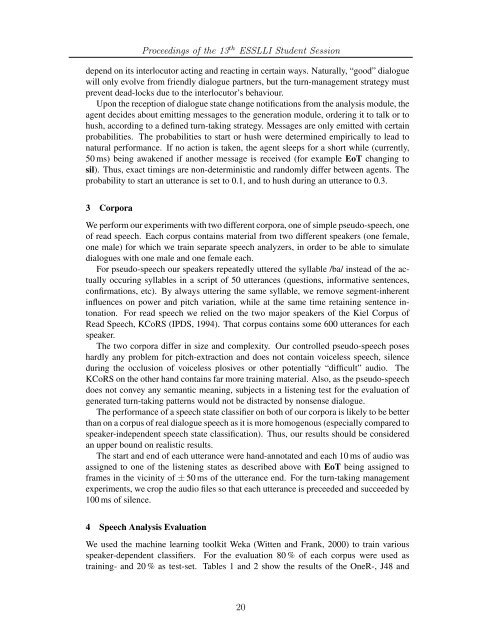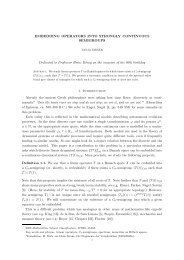Proceedings of the 13 ESSLLI Student Session - Multiple Choices ...
Proceedings of the 13 ESSLLI Student Session - Multiple Choices ...
Proceedings of the 13 ESSLLI Student Session - Multiple Choices ...
You also want an ePaper? Increase the reach of your titles
YUMPU automatically turns print PDFs into web optimized ePapers that Google loves.
depend on its interlocutor acting and reacting in certain ways. Naturally, “good” dialogue<br />
will only evolve from friendly dialogue partners, but <strong>the</strong> turn-management strategy must<br />
prevent dead-locks due to <strong>the</strong> interlocutor’s behaviour.<br />
Upon <strong>the</strong> reception <strong>of</strong> dialogue state change notifications from <strong>the</strong> analysis module, <strong>the</strong><br />
agent decides about emitting messages to <strong>the</strong> generation module, ordering it to talk or to<br />
hush, according to a defined turn-taking strategy. Messages are only emitted with certain<br />
probabilities. The probabilities to start or hush were determined empirically to lead to<br />
natural performance. If no action is taken, <strong>the</strong> agent sleeps for a short while (currently,<br />
50 ms) being awakened if ano<strong>the</strong>r message is received (for example EoT changing to<br />
sil). Thus, exact timings are non-deterministic and randomly differ between agents. The<br />
probability to start an utterance is set to 0.1, and to hush during an utterance to 0.3.<br />
3 Corpora<br />
<strong>Proceedings</strong> <strong>of</strong> <strong>the</strong> <strong>13</strong> th <strong>ESSLLI</strong> <strong>Student</strong> <strong>Session</strong><br />
We perform our experiments with two different corpora, one <strong>of</strong> simple pseudo-speech, one<br />
<strong>of</strong> read speech. Each corpus contains material from two different speakers (one female,<br />
one male) for which we train separate speech analyzers, in order to be able to simulate<br />
dialogues with one male and one female each.<br />
For pseudo-speech our speakers repeatedly uttered <strong>the</strong> syllable /ba/ instead <strong>of</strong> <strong>the</strong> actually<br />
occuring syllables in a script <strong>of</strong> 50 utterances (questions, informative sentences,<br />
confirmations, etc). By always uttering <strong>the</strong> same syllable, we remove segment-inherent<br />
influences on power and pitch variation, while at <strong>the</strong> same time retaining sentence intonation.<br />
For read speech we relied on <strong>the</strong> two major speakers <strong>of</strong> <strong>the</strong> Kiel Corpus <strong>of</strong><br />
Read Speech, KCoRS (IPDS, 1994). That corpus contains some 600 utterances for each<br />
speaker.<br />
The two corpora differ in size and complexity. Our controlled pseudo-speech poses<br />
hardly any problem for pitch-extraction and does not contain voiceless speech, silence<br />
during <strong>the</strong> occlusion <strong>of</strong> voiceless plosives or o<strong>the</strong>r potentially “difficult” audio. The<br />
KCoRS on <strong>the</strong> o<strong>the</strong>r hand contains far more training material. Also, as <strong>the</strong> pseudo-speech<br />
does not convey any semantic meaning, subjects in a listening test for <strong>the</strong> evaluation <strong>of</strong><br />
generated turn-taking patterns would not be distracted by nonsense dialogue.<br />
The performance <strong>of</strong> a speech state classifier on both <strong>of</strong> our corpora is likely to be better<br />
than on a corpus <strong>of</strong> real dialogue speech as it is more homogenous (especially compared to<br />
speaker-independent speech state classification). Thus, our results should be considered<br />
an upper bound on realistic results.<br />
The start and end <strong>of</strong> each utterance were hand-annotated and each 10 ms <strong>of</strong> audio was<br />
assigned to one <strong>of</strong> <strong>the</strong> listening states as described above with EoT being assigned to<br />
frames in <strong>the</strong> vicinity <strong>of</strong> ± 50 ms <strong>of</strong> <strong>the</strong> utterance end. For <strong>the</strong> turn-taking management<br />
experiments, we crop <strong>the</strong> audio files so that each utterance is preceeded and succeeded by<br />
100 ms <strong>of</strong> silence.<br />
4 Speech Analysis Evaluation<br />
We used <strong>the</strong> machine learning toolkit Weka (Witten and Frank, 2000) to train various<br />
speaker-dependent classifiers. For <strong>the</strong> evaluation 80 % <strong>of</strong> each corpus were used as<br />
training- and 20 % as test-set. Tables 1 and 2 show <strong>the</strong> results <strong>of</strong> <strong>the</strong> OneR-, J48 and<br />
20

















